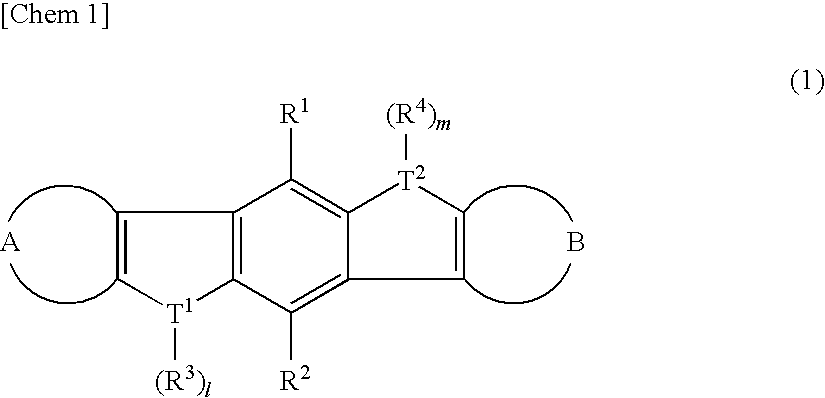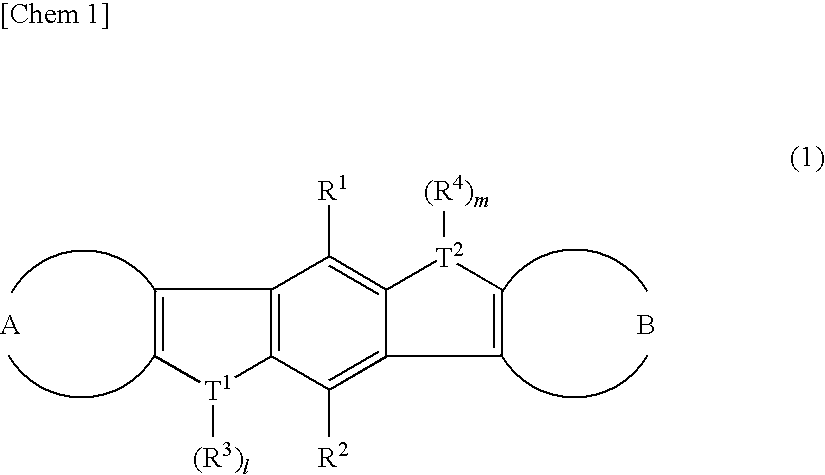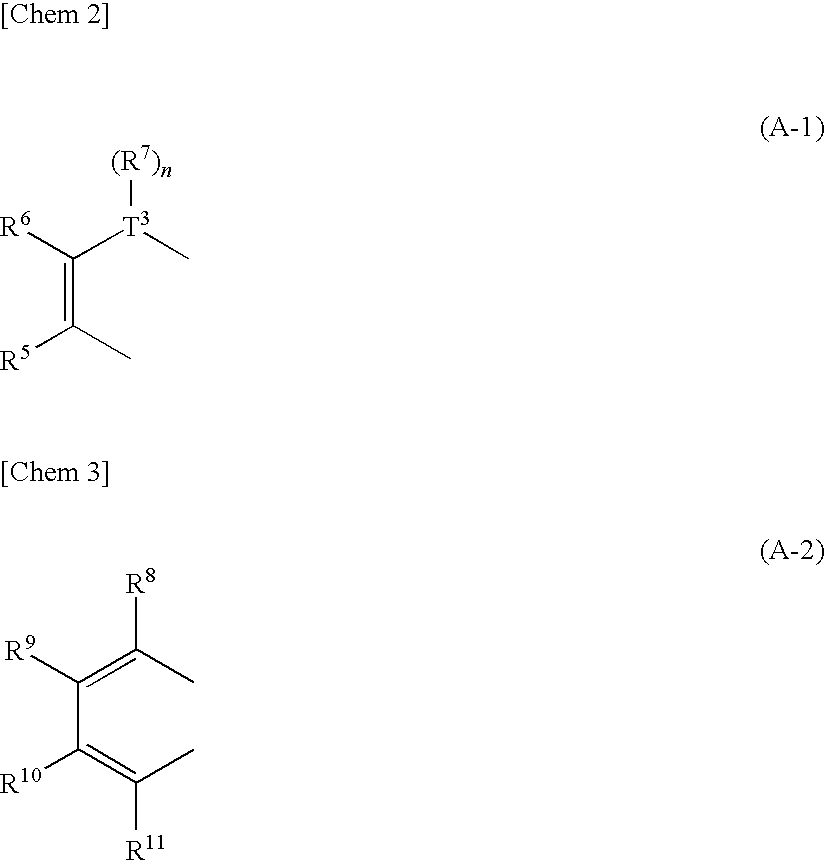Heteroacene derivative, tetrahaloterphenyl derivative, and processes for producing the same
a technology of tetrahaloterphenyl and acene, which is applied in the direction of halogenated hydrocarbon preparation, non-metal conductor, conductor, etc., can solve the problems of difficult processing and economic viewpoint, low performance of organic semiconductor devices, and difficulty in forming organic semiconductor active phases from materials. , to achieve the effect of excellent oxidation resistan
- Summary
- Abstract
- Description
- Claims
- Application Information
AI Technical Summary
Benefits of technology
Problems solved by technology
Method used
Image
Examples
synthetic example 1
Synthesis of 1,4-Dibromo-2,5-diiodobenzene)
[0108]1,4-Dibromo-2,5-diiodobenzene was synthesized with reference to the method described in Journal of American Chemical Society, 1997, vol. 119, pp. 4578-4593.
[0109]To a 1 L three-necked flask fitted with a mechanical stirrer were added 16.7 g (73.0 mmol) of periodic acid and 525 ml of sulfuric acid. After periodic acid was dissolved, 36.4 g (219 mmol) of potassium iodide was added portionwise. The content was cooled to a temperature of −30° C. and 34.5 g (146 mmol) of 1,4-dibromobenzene was added over a period of 5 minutes. The resulting mixture was stirred at −25° C. for 36 hours. After the reaction mixture was poured into ice (2 kg), the whole was filtrated and a solid was taken out. The solid was dissolved in chloroform, the solution was washed with a 5% aqueous sodium hydroxide solution and water, and the organic phase was dried over anhydrous magnesium sulfate. After concentration under reduced pressure, the residue was recrystalli...
synthetic example 2
Synthesis of 2-Phenyl-5-bromo-4-biphenylboronic Acid
1) Synthesis of 1,2-Dibromo-4,5-diiodobenzene
[0112]1,2-Dibromo-4,5-diiodobenzene was synthesized in accordance with “Synlett”, 2003, pp. 29-34.
[0113]To a 1 L three-necked flask fitted with a mechanical stirrer were added 36.9 g (162 mmol) of periodic acid and 150 ml of sulfuric acid. After periodic acid was dissolved, 80.7 g (486 mmol) of potassium iodide was added portionwise. The content was cooled to a temperature of 0° C. and 75.0 g (318 mmol) of 1,2-dibromobenzene was added. The resulting mixture was stirred at 0° C. for 30 minutes. After the reaction mixture was poured into ice, the whole was filtrated and a solid was taken out. The solid was recrystallized twice from THF / methanol to obtain white crystals (76.2 g, yield 49%).
[0114]1H-NMR (CDCl3, 21° C.) δ=8.03 (s, 2H).
[0115]From the 1H-NMR measurement, it was confirmed that 1,2-dibromo-4,5-diiodobenzene was obtained.
2) Synthesis of 1,2-Dibromo-4,5-diphenylbenzene
[0116]To a 20...
synthetic example 3
Synthesis of 2-Bromo-3-iodonaphthalene
[0121]2-Bromo-3-iodonaphthalene was synthesized with reference to the method described in Synthetic Communications, 2003, vol. 33, pp. 2751-2756. A starting material, 2-bromo-bis(hexachlorocyclopentadiene)-naphthalene was purchased from Sigma-Aldrich and used as it was.
[0122]To a 500 ml three-necked flask reaction vessel were added under a nitrogen atmosphere 200 ml of methanesulfonic acid and 1.31 g (5.74 mmol) of orthoperiodic acid. After 30 minutes of stirring, 4.36 g (17.2 mmol) of iodine was added thereto. After the mixture was stirred for 2 hours, 30.1 g (40.0 mmol) of 2-bromo-bis(hexachlorocyclopentadiene)naphthalene was added portionwise. The mixture was stirred at 30° C. for 3 days. The reaction mixture was poured into ice water and the formed solid was filtrated. The solid was further washed with water and dried under reduced pressure to obtain a white powder of 2-bromo-3-iodo-bis(hexachlorocyclopentadiene)naphthalene (34.8 g, yield 99...
PUM
| Property | Measurement | Unit |
|---|---|---|
| structure | aaaaa | aaaaa |
| flexibility | aaaaa | aaaaa |
| carrier mobility | aaaaa | aaaaa |
Abstract
Description
Claims
Application Information
 Login to View More
Login to View More - R&D
- Intellectual Property
- Life Sciences
- Materials
- Tech Scout
- Unparalleled Data Quality
- Higher Quality Content
- 60% Fewer Hallucinations
Browse by: Latest US Patents, China's latest patents, Technical Efficacy Thesaurus, Application Domain, Technology Topic, Popular Technical Reports.
© 2025 PatSnap. All rights reserved.Legal|Privacy policy|Modern Slavery Act Transparency Statement|Sitemap|About US| Contact US: help@patsnap.com



